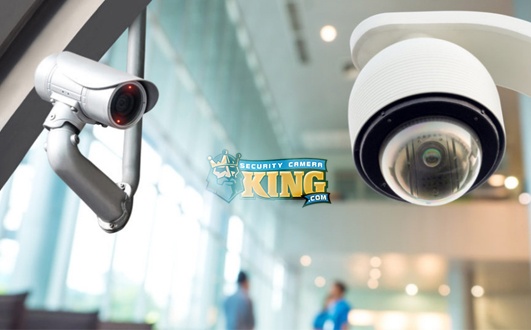Pan Tilt Zoom (PTZ) security cameras have become one of the more popular types of surveillance cameras that are on the market today. There are many different types of security cameras available today which can fill a wide range of the roles that their owners can ask of them. Even with the wide variety of cameras today, PTZ cameras are arguably the most versatile security camera that you can find. This article will go into how to configure a PTZ and what a PTZ can do.
The basic functions of this type of camera enable it to pan horizontally, tilt vertically and zoom in and out to various magnification levels. These cameras allow you to remotely control them from a DVR or over the Internet provided the DVR has been connected to a network. Depending on the particular camera, it can be zoomed in to a maximum zoom level of anywhere between 3x and 40x magnification mechanically. Some of the models of PTZ cameras will even have a digital zoom function built in to them that will extend this range of magnification. These PTZ functions allow the user to be able to log in to your DVR from a computer while away from the location where it is installed and take a look around. This can give you some extra peace of mind while you’re on vacation or just away from the location that you have protected with security cameras. You can also leave the camera pointing at whatever area is considered to be the most likely place for potential trouble.
Different models of these cameras can pretty much offer every feature that you can get in any other security camera in addition to a few that are only available on a PTZ camera. These cameras can include the ability to compensate for every conceivable lighting condition and be mounted to nearly any surface with an array of different types of mounts. Some of the features that are exclusive to PTZ cameras are the ability to automatically track a moving object, have a custom pattern which the camera will continuously follow and they can also be set up to return to a custom home position after a certain amount of inactivity. Many of the newer models of PTZ cameras that are available today will let you modify the settings for these features from the camera’s OSD (On Screen Display). Increasingly you can also adjust the settings for the basic functions of a PTZ camera through the OSD; these settings include the camera’s protocol, address and baud rate.
Installing a PTZ camera is a relatively simple matter that is only slightly more difficult than installing a fixed camera. The majority of these cameras have the standard wires and connectors for power and video transmission that all surveillance cameras have. They also have another pair of wires that either just have bare wire at the end or have a small post connected to the end. The purpose of these wires is to make it possible to establish control of the camera’s movement from the DVR. If you are installing one of these cameras you will need use a pair of wires from a CAT5 cable, 18/2 power wire or another similar cable to extend these wires back to the RS-485 connection at the DVR.
Here at SecurityCameraKing.com we carry several different models of PTZ cameras in order to suit your requirements and budget. Now we’re going to take a look at how to set up one of more popular models, the PTZ-LX700L12X-E, and access some of the features that this camera has built in to it. The first thing that you should do with any camera is test it by setting up completely while it’s un-mounted and close to the DVR. When you’re doing this it’s a good idea to get the camera to the point where you can see video on the DVR from it. In the case of a PTZ camera you should also get to the point where you can control the camera movement from the DVR.
When you take a PTZ-LX700L12X-E out of the box you’ll notice that there are four wires coming off of it. There is one for power, one for video transmission and two for establishing control of the camera (as shown in image 1).

Image 1
The power and BNC video connectors need to be hooked up in the same manner that you would use with most analog security cameras. When you first power a PTZ camera up you should see it automatically rotate though it’s range of motion. The two control wires will need to be extended so that they will reach the RS-485 port in the back of the DVR. If you are connecting this camera to one of our DVRs then the positive control wire will need to be connected to the “A” slot in the RS-485 and the negative control wire will need to be connected to the “B” slot of the same terminal. This type of physical set up is pretty common for the installation of most PTZ cameras.
It’s a good idea to connect the power to the camera last. Once this camera powers up you will see some information about it displayed over the camera’s view at the DVR. There are three parts of this data that will be useful in the initial setup – the protocol that the camera is set for, the camera’s current address, and the baud rate that camera is set up to use (as shown in image 2). This list of information will also tell you two ways that you can access the camera’s OSD through the DVR – by hitting the plus iris button or entering preset 95 from the PTZ control interface of our DVRs. You won’t need to get into the OSD for the initial set up unless you need to change the protocol, baudrate or address of the camera.

Image 2
Once you have the camera connected correctly you will need to make some setting changes in the DVR in order to be able to establish control of the PTZ camera. When you are in front of the DVR this is done by right clicking anywhere on the screen, then select Main Menu. Once you’re on the Main Menu, click on the setting button and then the pan/tilt/zoom button.
It’s important to realize that there is a different version of this page for channel that your DVR has. The first thing that you should do on this page is select the channel where your PTZ camera is connected. Next you will need to set the protocol, baudrate or address of the camera. The will be the same information that was provided on the information screen when you first powered the camera up (as shown in image 2). You will not need to make any changes to the data bit, stop bits or parity settings.
At this point you should be able to control the camera from the DVR’s PTZ interface. To get to this interface you will need to start with just your live camera views on screen with no menus being displayed. Then you right click anywhere on the screen and select pan/tilt/zoom from the small menu that appears. This will bring the PTZ control interface, which has eight outward facing arrows that is arranged in a circular pattern. This is also the menu that allows you to access the camera’s OSD.












